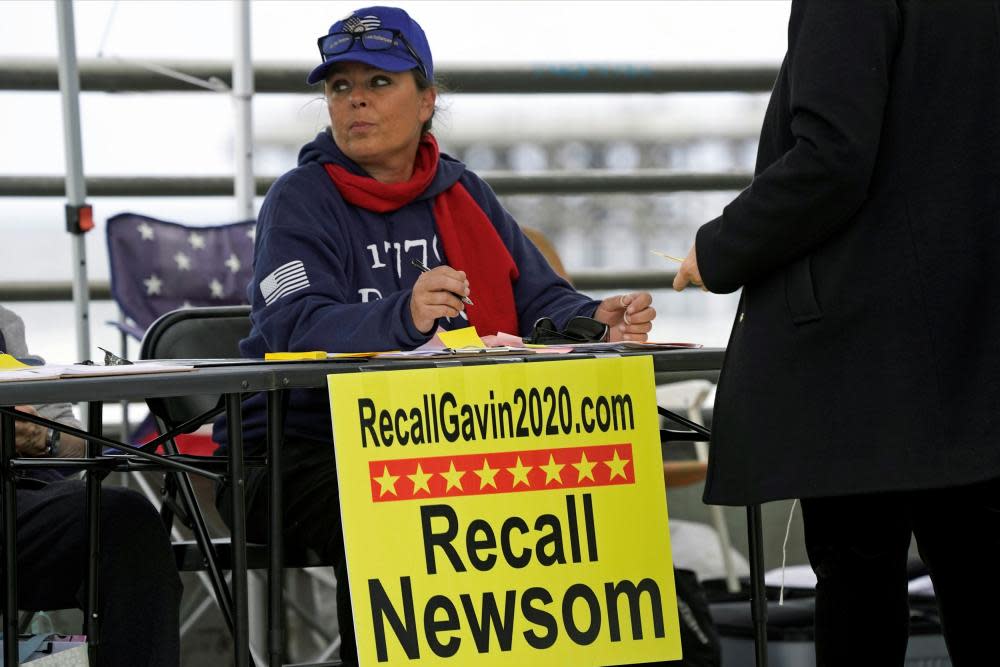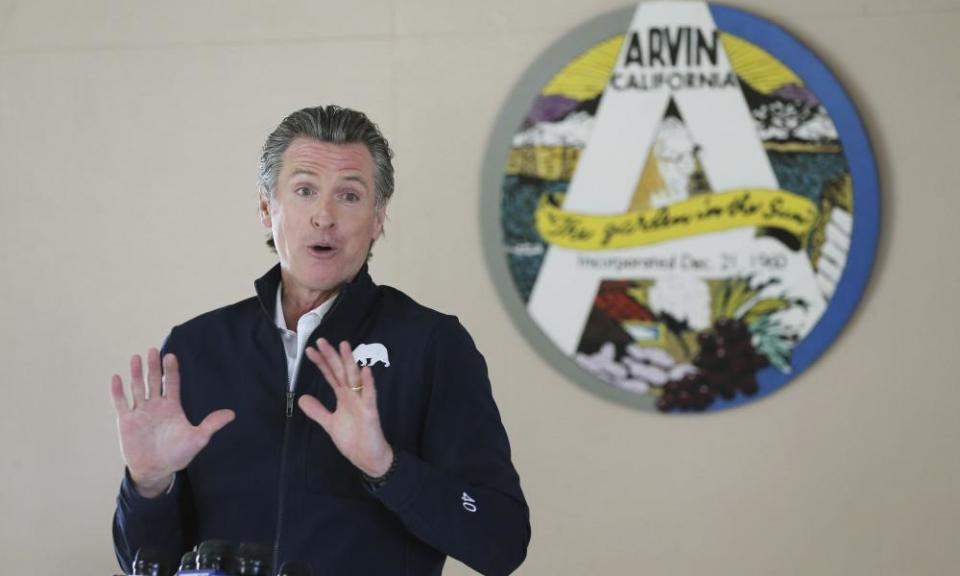Push to recall California governor Gavin Newsom gains steam – but who's behind it?

Across California, hundreds of thousands of people armed with signs and clipboards are gathering outside of local Walmarts, in shopping center parking lots and on beachside boardwalks, trying to convince their neighbors that the governor needs to go.
An effort to recall Gavin Newsom has gained momentum in recent weeks, as the California governor’s approval ratings dipped amid mounting frustration over how the state has handled the Covid pandemic, and the economic slump caused by closures.
Related: What we know about the California coronavirus variant
So far, the campaign appears on track to get the signatures they need by a deadline of 17 March. If their efforts succeed, a recall election could be held before the end of the year.
“We knew this was going to be big. We didn’t know it was going to be this big” said Randy Economy, a spokesperson and political adviser for the RecallGavin2020 campaign.
It’s still extremely unlikely that a majority of Californians would choose to oust Newsom. State records show almost every California governor since 1960 has faced recall efforts, but only one – Gray Davis in 2003 – has been successfully removed. Newsom, who defeated his Republican opponent by 24 points in 2018, has largely retained enough support from the Democratic base needed to keep him in power, despite the challenges of 2020.
Though his popularity has waned in recent months, analysts say the success of the recall movement is more of a reflection of a political polarization in the state that has widened during the pandemic and the 2020 election. The campaign has catered to conservative Californians who feel unheard by the Democratic supermajority who run the state, and the recall has gained traction and resources from a small but vocal Republican electorate.
“He has been a very polarizing figure,” said Mark Baldassare, the president and CEO of the Public Policy Institute of California of the California governor. “Democrats are overwhelmingly supporting him and Republicans overwhelmingly disapprove of him.”
PPIC has polled voters 12 times on Newsom’s performance since he was elected and Baldassare said the numbers have remained fairly stable, even accounting for recent drops. Recent surveys done by the PPIC showed only 43% of likely voters disapprove of the governor. By comparison, former governor Davis had disapproval ratings in the 70s when he was ousted from office.
The recall campaign was launched by Orrin Heatlie, a Republican and retired Yolo County sheriff’s sergeant, in February of last year, long before Covid lockdowns caused Newsom’s approval numbers to tumble.
Their logo features a California Bear – teeth bared – with one paw defiantly raised. The other holds the state etched with a list of grievances, including gun control, “free illegal immigrant health care” and “reducing police support”. While organizers initially rooted the campaign in complaints over California’s high taxes, the housing and homelessness crisis, and other issues, focus has pivoted to Covid policy – particularly Newsom’s use of executive orders, the failures of the state’s unemployment agency, which is still grappling with backlogs and fraud cases, and state-mandated shutdowns that caused business closures.
The movement also got a bump in support after Newsom was caught mask-less, eating inside at French Laundry, the luxurious Napa restaurant, after asking Californians to stay home and cover their faces while in public.
“He owned the situation, and owned the pandemic, and owned the way we were going to get out of this,” Economy said. “Once he owned it and excluded anyone else from the process – that’s when he lost control.”
Economy claims the movement includes Californians of all political stripes, adding that they are proud to “have been able to organize an army of residents from all walks of life”. But so far, the recall effort has had close ties to the right, with both the Republican establishment and conservative fringe groups fueling the campaign.
By early February, the effort had raised more than $2.5m according to financial disclosures filed with the state, and Rescue California, the organization created to remove Gray Davis from office in 2003 has been a major contributor. The recall has also been bankrolled the former Arkansas governor and ardent Trump supporter Mike Huckabee’s political action committee, and the California Republican party. There was also a contribution of $500,000 from a company called Prov. 3:9 LLC, which triggered a “dark money” complaint by the former chair of the Federal Election Commission over accusations that the organization is a shell company to disguise donors.

According to a recent ABC News analysis, the majority of signatures so far have come from the agricultural Central Valley, the conservative hub of Orange county, and the far-north parts of the state where a secession movement has simmered for years. In the liberal Bay Area, meanwhile, less than 1% of registered voters have signed on.
An investigation done by the Los Angeles Times, published in January, also showed that the recall campaign had early ties to far-right extremist groups, including QAnon conspiracists, self-proclaimed western chauvinists the Proud Boys and activists from the anti-vaccination movement. Organizers from the anti-government group the Three Percenters have helped collect signatures and, in recent months, the Times found the same violent rhetoric, false assertions of election fraud, and propaganda that fueled the 6 January Capitol attack, were being shared on campaign’s Facebook pages, alongside ominous-looking photos of the California governor.
“This recall effort, which really ought to be called the California coup, is being led by rightwing conspiracy theorists, white nationalists, anti-vaxxers and groups who encourage violence on our democratic institutions,” Rusty Hicks, California’s Democratic party chair, told reporters in January.
Organizers of the recall have rejected the claims, and have attempted to distance the campaign from the turmoil in Washington. Economy balked at the association, saying that Hicks’s statement showed signs of panic from the Democratic establishment.
Newsom himself has tried not to appear fazed, however, declining to discuss the recall, even as momentum grows. In his official response to the secretary of state’s office, he called the effort wasteful, and diminished the large numbers to “a handful of partisan activists supporting President Trump and his dangerous agenda” who are trying to overturn the will of California voters.
But even if the recall effort fails to remove Newsom from office, it could have a lasting impact on his political future – especially if the campaign further erodes confidence in him across party lines. Newsom was elected, in part, because California’s Democratic majority wanted the state to lead the resistance against the Trump administration. Now, with Biden in office, Newsom needs to prove he can achieve some of his ambitious promises and navigate a challenging Covid recovery. Otherwise, some constituents could change their minds about him.
“When things don’t go right with the vaccine rollout, the opening of the economy and schools and so forth – the governor can’t blame the unpopular president any more,” Baldassare said. “People will be looking to him to make some substantial progress.”

